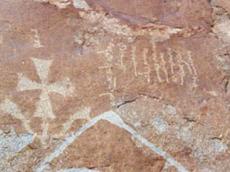 By AzerNews 6 May 2014
By AzerNews 6 May 2014The famous Issyk inscription found in 1969 is not the only example of the Scythian-Saka written language.
The news was announced by employee of the Azerbaijan's Archaeology and Ethnography Institute Zaur Hasanov who talked to local media.
In addition to the inscriptions of the Issyk kurgan, two inscriptions of the Scythian period were discovered in Kazakhstan, the scientist said.
Found by prominent Kazakh scientist Zholdasbek Kurmankulov as a result of some excavations in 2005 in the ancient Scythian-Saka settlement, now known as Chirik Rabat, they date back to 4-2 centuries BC.
The first amphora-shaped vessel was found in the ruins of the temple. Five signs are incised on it - one on the top of the vessel and four others beneath it.
The second vessel was discovered in a tomb with burial place, together with a long iron sword. At the head of the body there was a ceramic flask with an inscription which begins with an ideogram and is followed by five signs.
The ideogram and five signs in these two vessels are similar to the signs of the Issyk inscription, the scientist said.
The remaining five signs are identified with Orkhon - Yenisei and Middle Eastern Aramaic signs. The inscriptions on both vessels have no vowels, and this, Zaur Hasanov says, is the main difference between Chirik-Rabat inscriptions and inscriptions from the Issyk kurgan.
Reading inscriptions on the first amphora-shaped vessel gave the following result: Iga Ak deniz - "Ruler of the White Sea". The inscription on the second vessel can be read as Dort bul Alpana il ok - "Four (angles) sides of the world, tribe obeying Alpanians".
The scientist said the term "White Sea" in ancient Turkic languages ??means "Western Sea". As researches show, ancient Turks marked cardinal points by different colors. For example, black was used to mark North. Therefore, the term "Black Sea" means "North Sea" in Turkish languages?. South and East were marked by yellow (gold) and sky-blue respectively.
It is not difficult to guess that for the people who lived in Chirik-Rabat, "West Sea" meant the Caspian Sea, and, consequently, "Ruler of the Caspian Sea" was mentioned in the text. It is also important to note that in medieval written sources the Caspian Sea is sometimes called Akdeniz, the scientist emphasizes.
But what is most important, Zaur Hasanov was able to establish that another Albania, more precisely, Alpania existed in the east of the Caspian Sea. Based on archaeological evidence, it turns out that some people, who called themselves Alpanians, lived on the east coast of the Caspian Sea.
The study of ancient Greek and Roman sources, especially the geographical map of the world initially compiled by the Roman emperor Octavian Augustus's son-in-law, resulted in surprising information about these people.
This map shows the location of the famous Atropatena in the place of the modern Azerbaijan. But there is also an image of the country of Albania, which is located on the river Kang. Given the fact that scientists have found that the river Kang is the modern Syrdarya, there was another Albania in the Roman period with its capital in the fortified city.
The evidence of its existence can be found in the Roman author Pliny the Elder's writings, indicating that when Alexander the Great was on his way to India, the Albanian king gave him a dog of unprecedented strength which defeated lions and elephants.
Obviously, it is not about Caucasian Albania, because the Caucasus is not on the way to India or even close to it.
The mistake of the scientists studying the history of Caucasian Albania, Hasanov says, lies in the fact that they mixed up all the information about various Albanias and identified them all as one region. This is a methodological error, the scientist believes.
The Caucasian Albania was one of the most important phenomena in the history of Eurasia, however, since there were other Albanias in the 4th century BC.
Zaur Hasanov says the historic land of the Turkic Alban family is located in the region of the Issyk kurgan. In modern Kazakhstan, there are 750,000 people from this tribe.
The same number of Albanians live in China at the border with Kazakhstan, he added.
As for the ancient times, the reading of the runic inscriptions on the flask from Chirik-Rabat and its comparison to the information on Roman maps shows that in 4-2 centuries BC, the Albanians moved far to the west and extended their power to the eastern coast of the Caspian Sea.
But it is not the only conclusion based on reading the texts from the ancient Turkic settlement Chirik-Rabat. Hasanov said the first and most important conclusion is that in the Scythian-Saka period, Turkic people familiar with script lived not only in the region of Issyk kurgan, but also the Caspian Sea region.
The second important conclusion is that in 4-2 centuries BC Turkish people had developed urban culture. The ancient settlement Chirik-Rabat, called Alban in ancient times, was the permanent residence of the Scythian-Saka rulers.
No comments:
Post a Comment